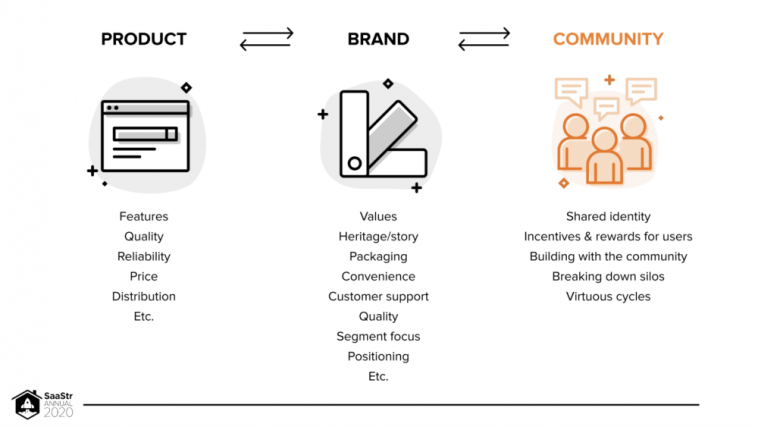- Like
- SHARE
- Digg
- Del
- Tumblr
- VKontakte
- Flattr
- Buffer
- Love This
- Save
- Odnoklassniki
- Meneame
- Blogger
- Amazon
- Yahoo Mail
- Gmail
- AOL
- Newsvine
- HackerNews
- Evernote
- MySpace
- Mail.ru
- Viadeo
- Line
- Comments
- Yummly
- SMS
- Viber
- Telegram
- JOIN
- Skype
- Facebook Messenger
- Kakao
- LiveJournal
- Yammer
- Edgar
- Fintel
- Mix
- Instapaper
- Copy Link
Prashanth Chandrasekar, CEO @ Stack Overflow recently shared with our community the four key pillars he feels are necessary to propel a company to scale upward.
The four key pillars he lays out are:
- Product market fit & expansion
- Go to market approach & expansion
- Competitive differentiation
- Building a stage-specific team
#1 Product-Market Fit and Expansion
Product. Is your product sound, and does it solve a big problem for customers, enough for you to scale? Once you figure that out, you can expand your scope.
- Market Fit. Deliver repeatable value early in the customer’s journey. Measure leading indicators and not lagging indicators like churn.
- Expansion. Review your customer’s problem journey at pre and post current stages. Can your product solve more of their problems? This will create use cases you can use to expand into adjacent organizations. Figure out what your immediate target group is all about and look for expansion opportunities.
#2 Go-To-Market Approach and Expansion
What are your options, and what are the most appropriate ones to use to give your company a competitive edge?
- Approach. Determine if your growth is product-led, sales-led, or marketing-led. Make sure you have alignment across your company. Determine if you want to offer Freemiums or free trials so customers can try your product before they buy. Determine if your company is direct vs. indirect sales-led for tech alliances, channels, and Student Information Systems. Positive unit economics must be fundamental to your company as you scale your long term fundamentals. All of this will help create value and return on investment capital.
- Expansion. There are three main dimensions to expansion:
- Industry verticals such as healthcare or financial present an opportunity to effectively leverage your Go-to-Market strategy, i.e., distribution, bundling of products, etc.
- Segments. SMB to Enterprise, decide which you want to start with and toward which you want to move.
- Geographic regions. With such worldwide growth these days and numerous opportunities, this can be a product expansion strategy.
#3 Competitive Differentiation
How do you stand out from the pack and grow despite plenty of competitors?
- Product is the best way to differentiate your company and includes your product’s features, quality, reliability, price, and distribution. Together, these factors enable you to distinguish your company.
- Brand includes your company values, Heritage/story, packaging, convenience, customer support, quality, segment focus, and positioning, all of which can differentiate your company from others with similar products.
- Community is one of the most underestimated ways to differentiate your company and its strategy. Five tenants to building a great community include a shared identity; incentives and awards for users to provide a sense of accomplishment; building with not for the community and building from within; breaking down silos and linking one associated community to another to help get a broader perspective; and virtuous cycles as ways to create a feedback loop with favorable results.
Note: the order in which you organize this is important. It can be the product, then brand, then community, or community, then brand, then product.
Building a Community
Over 80 percent of founders report building a community as important to their business, with 28 percent saying it is crucial to their success. In a society that’s becoming more remote, a community will become even more critical as a source of (competitive differentiation) in an increasingly virtual world.

#4 Stage-Specific Team
Each company must have different teams with different skills to achieve your desired growth.
- Early-stage. The product team is a small, tight-knit group focused on product, architecture, and engineering. There’s a lot of focus on direct customer feedback about how your product solves enormous problems for them and any issues they might have with your product. The go-to-Market team has an Evangelist sales leader with scrappy sales and customer success members.
- Mid-stage. This stage includes companies with sales between $25M and $75M. They have a Full Product Team, which includes product management, user research, and product design. The go-to-Market team has a Builder VP of Sales. Sales cadence, pipeline, and methodology become essential here, and there is a specialized sales organization with inbound and outbound sales development and a separate customer success organization.
- Late-stage. The Product team incorporates previous mid-level stage items plus the true voice of the customer, roadmaps, and reviews of processes. There is a deliberate focus on market differentiation vs. market relevance as it relates to investment. There will be more competition at this phase, so resource allocation becomes paramount. Go-to-Market’s team leader must be a forecasting machine and predictability VP of Sales. Included are all the mid-stage items plus sales enablement and operations to include sales strategy, territory planning, deal desk, and more.


